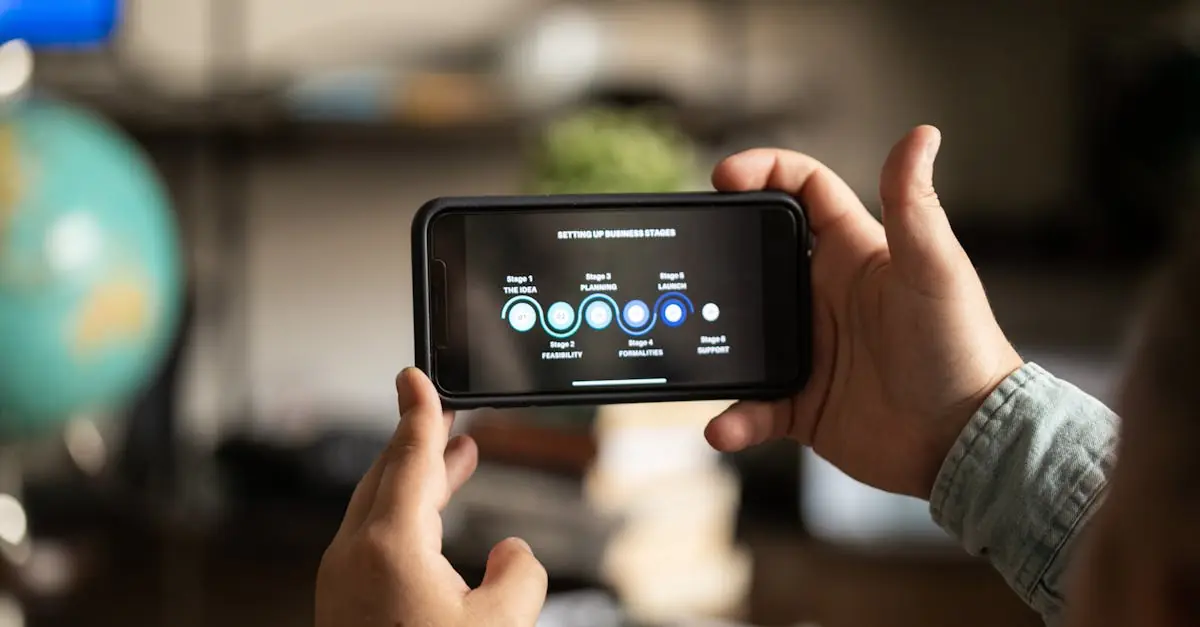Table of Contents
ToggleIn the fast-paced world of technology, mobile apps reign supreme. They’re like the Swiss Army knives of the digital realm—handy, multifunctional, and always at your fingertips. But before that shiny app can grace the screens of eager users, it must journey through the mobile app development lifecycle. Think of it as the epic quest every app must embark on, complete with planning, design, development, and testing.
Overview of Mobile App Development Lifecycle
Mobile app development follows a structured lifecycle, consisting of distinct stages that contribute to a successful application. Each stage plays a critical role in transforming an idea into a functional app.
Planning: This initial stage defines the app’s purpose and identifies target users. Researching competitors is essential for understanding market trends and demands. Establishing a clear roadmap and setting objectives generate focus for the entire project.
Design: The design phase emphasizes creating a user-friendly interface and experience. Wireframes outline the app’s layout, while user journey maps help visualize interactions. Prioritizing aesthetics and usability is crucial, as these elements impact user satisfaction.
Development: During development, coding transforms designs into a working product. Developers choose the appropriate technologies and frameworks based on project requirements. Continuous communication among team members ensures alignment and adherence to the initial vision.
Testing: Testing validates the app’s functionality and performance. Various testing methods, such as unit, integration, and user acceptance testing, identify bugs or issues. Consistent feedback from testers aids in refining the app’s user experience and performance.
Deployment: After testing confirms readiness, the deployment stage involves launching the app on platforms like the App Store or Google Play. Marketing strategies, including social media promotions and influencer collaborations, drive visibility to attract users.
Maintenance: Post-launch maintenance allows for updates and improvements. Gathering user feedback is vital for addressing issues and implementing new features. Regular maintenance ensures the app remains relevant and competitive in the evolving market landscape.
Phases of Mobile App Development Lifecycle
The mobile app development lifecycle includes several distinct phases that ensure the successful creation of an app. Each phase plays a vital role in delivering a product that meets user expectations and business goals.
Planning Phase
During the planning phase, defining the app’s goals is essential. Teams conduct market research to identify the target audience and analyze competitors. Clear documentation of the app’s features shapes the project scope. Timeframes and budgets often emerge from initial discussions, providing clarity throughout the process. Setting measurable objectives helps track progress in later stages.
Design Phase
The design phase prioritizes user experience and interface usability. Designers create wireframes to visualize the app’s layout, ensuring it aligns with user needs and behaviors. Prototyping enables teams to test design concepts early, gathering feedback to enhance usability. Color schemes, typography, and graphic elements play key roles in crafting a visually appealing app. Each design decision contributes to the overall branding strategy.
Development Phase
In the development phase, coding transforms designs into functional applications. Developers choose appropriate programming languages and frameworks based on the project’s requirements. Collaborations between front-end and back-end teams foster efficient workflows. Regular updates and code reviews ensure adherence to project specifications. Each iteration brings the app closer to completion, often involving continuous integration practices.
Testing Phase
The testing phase focuses on identifying and resolving issues before launch. Quality assurance teams conduct various tests, including functional, performance, and security assessments. Regression testing ensures that new code doesn’t disrupt existing features. User feedback during beta testing provides valuable insights. Comprehensive testing strategies enhance app reliability, paving the way for a smoother launch.
Deployment Phase
Deployment marks the introduction of the app to the public. Submission to platforms like the App Store or Google Play requires adherence to their guidelines. Marketing strategies create buzz around the app’s release, attracting initial users. Monitoring analytics from the outset helps assess user engagement and gather insights for future improvements. Each deployment phase delivers the app to its audience, starting its journey in the market.
Maintenance Phase
Post-launch, the maintenance phase keeps the app relevant and functional. Regular updates address user feedback, fix bugs, and introduce new features. Monitoring app performance identifies areas for improvement, ensuring its competitiveness. Engaging with users through updates fosters loyalty and satisfaction. Continuous assessment of market trends informs future enhancements, aligning the app with evolving user needs.
Best Practices in Mobile App Development Lifecycle
Understanding best practices enhances the mobile app development lifecycle. Prioritizing user experience stands as a fundamental principle. Developers focus closely on usability, ensuring that navigation is intuitive and features are accessible.
Market research drives informed decision-making. Teams identify target demographics, studying competitors and trends to tailor functionalities. Gathering user feedback early influences design and development, optimizing the app for its audience.
Designing for multiple devices and screen sizes remains essential. Responsive design techniques allow apps to function seamlessly across various platforms, enhancing user satisfaction. Keeping the design simple yet appealing often results in higher engagement.
Code quality affects maintainability and performance. Implementing coding standards and conducting peer reviews minimizes bugs and improves efficiency. Frequent code updates and modular programming contribute to a robust architecture.
Testing at multiple stages is critical. Developers and quality assurance teams conduct unit tests, integration tests, and user acceptance tests. This multi-faceted approach catches issues early, reducing costs and ensuring reliability before deployment.
Using analytics tools post-launch provides insights into user behavior. Monitoring app performance and user engagement leads to informed updates and feature enhancements. Regular maintenance keeps the app functional and aligned with evolving market demands.
Documenting processes throughout the lifecycle fosters collaboration and knowledge sharing. Clear documentation allows teams to revisit design rationale and coding decisions, simplifying onboarding for new members.
Overall, adhering to these practices leads to high-quality mobile applications that meet user expectations and perform well in competitive markets.
Tools and Technologies for Mobile App Development
Mobile app development relies on various tools and technologies that shape each stage of the lifecycle. Developers often use integrated development environments (IDEs) to streamline coding. Examples of popular IDEs include Android Studio for Android apps and Xcode for iOS apps. These platforms offer essential features like debugging and testing tools.
Frameworks play a crucial role in speeding up the development process. React Native and Flutter enable cross-platform compatibility, allowing developers to create apps for both Android and iOS from a single codebase. This approach reduces time and resource expenditure while maintaining a high-quality user experience.
Version control systems such as Git enhance collaboration among team members. By tracking changes in the codebase, developers can manage multiple project versions efficiently. This ensures that everyone is on the same page, minimizing errors during development.
For backend development, cloud platforms like Firebase and AWS provide essential services. These platforms offer scalable databases, authentication, and analytics features, all of which support app functionality and user engagement. Integrating these services helps teams focus on building the app without worrying about infrastructure.
Testing tools also contribute significantly to the app’s success. Automated testing frameworks like Appium and Selenium facilitate rigorous testing processes. These tools ensure apps function correctly across different devices and operating systems, reducing the chance of critical bugs at launch.
Analytics tools are essential post-launch, offering insights into user interactions. Google Analytics for mobile apps allows teams to track user engagement and behavior. This data informs future updates and feature enhancements, helping the app stay relevant in an evolving market. Each of these tools and technologies fosters a more efficient and effective mobile app development lifecycle.
The mobile app development lifecycle is a vital framework guiding developers from concept to launch and beyond. Each stage plays a crucial role in ensuring the app meets user needs and market demands. By prioritizing best practices and utilizing the right tools and technologies, teams can enhance efficiency and deliver high-quality applications.
Staying adaptable and responsive to user feedback and market trends is essential for ongoing success. As the mobile landscape continues to evolve, embracing this lifecycle will empower developers to create innovative solutions that stand out in a competitive marketplace.





